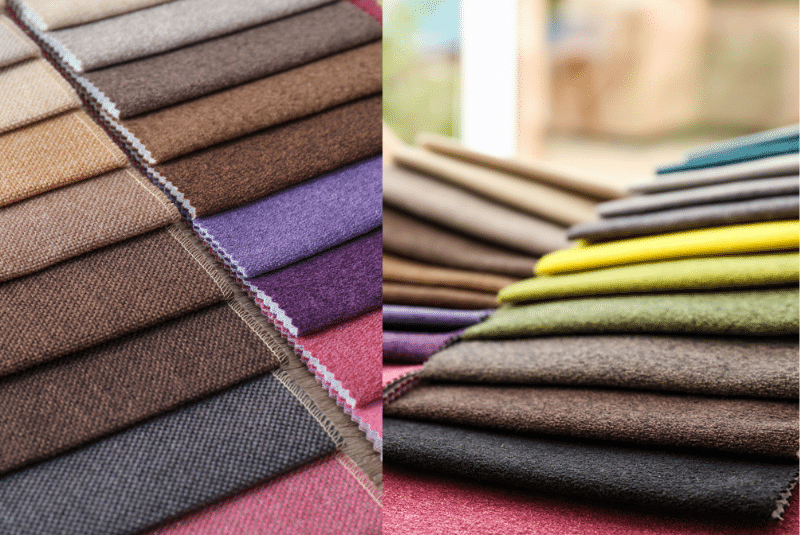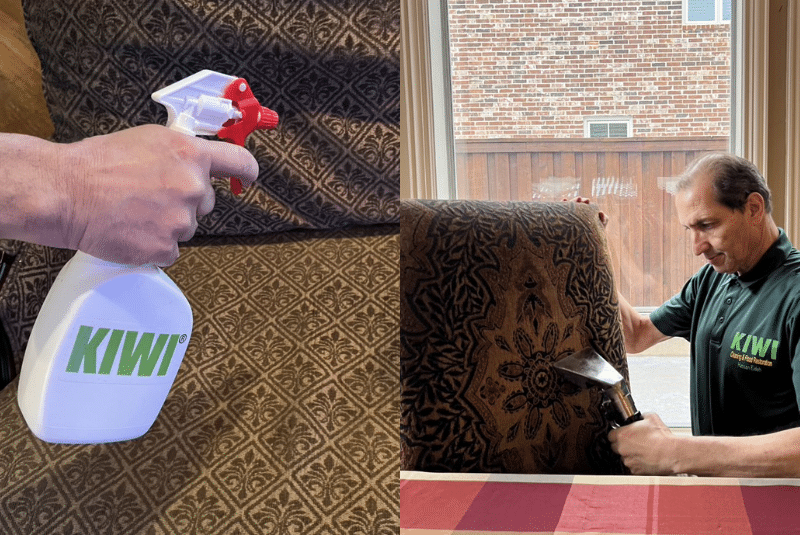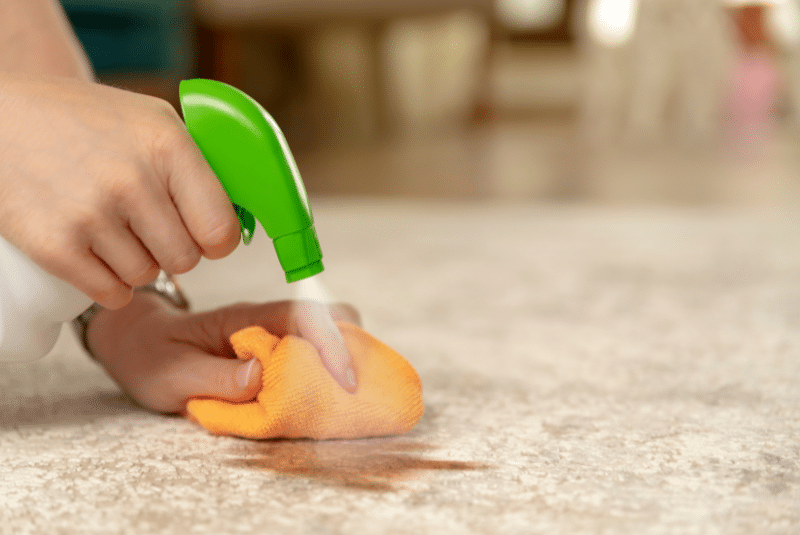Table of Contents
Maintaining the upholstery in your home is not just about keeping your furniture looking its best; it’s about extending the life and vitality of some of your most-used items. Every piece of upholstered furniture, from your cherished armchair to the family-sized sofa, thrives with tender loving care. Yet, many of us are unsure where to start or what techniques suit different materials.
This blog post will dive into upholstery maintenance, providing practical, easy-to-follow tips and tricks. From identifying your upholstery material to handling deep stains and odors, our goal is to equip you with all the knowledge you need to keep your furniture looking fresh and new. Whether dealing with an accidental spill or routine care, we’ve covered you with expert advice tailored for any upholstery enthusiast.
Let’s begin by understanding the materials that might adorn your living spaces and how their care differs. This foundational knowledge will ensure that your efforts are effective and safe for the type of upholstery you’re dealing with.
Understand Your Upholstery Material
Before you can effectively maintain your upholstery, it’s crucial to understand what materials you’re dealing with. Different fabrics require different care strategies, and using the wrong method can sometimes do more harm than good. Here’s a guide to help you identify and care for the most common types of upholstery materials:
Fabric Upholstery
Fabric is the most common upholstery material and comes in varieties such as cotton, linen, wool, and synthetic blends. Each type has its cleaning requirements:
- Cotton and linen are durable but highly absorbent and prone to shrinking if not handled properly.
- Wool needs gentle, low-moisture cleaning methods to avoid shrinking and distortion.
- Synthetics, like polyester or microfiber, are generally easier to clean and more stain-resistant.
Leather Upholstery
Leather offers a luxurious look and feel but demands regular maintenance to prevent cracking and drying out:
- Regularly wipe down with a clean, damp cloth to remove dust and small particles.
- Use specialized leather conditioners to keep the leather supple and prevent cracks.
Synthetic Leather
Also known as faux leather, it provides the appearance of leather at a more affordable price point and is easier to care for:
- Clean with mild soap and water, but avoid harsh chemicals that can peel or crack the surface.
Velvet
Velvet can be made from either natural or synthetic fibers and requires careful handling to maintain its luxurious texture:
- Avoid using water to clean velvet as it can damage the fibers; opt for dry cleaning methods.
Tips for Identifying Your Upholstery
If you’re unsure about the type of upholstery you have, consider these tips:
- Check the Manufacturer’s Label: Most furniture will have a tag with cleaning codes and material information.
- Perform a Touch Test: Materials like leather and velvet have a distinct feel. Leather is cool to the touch, while velvet is soft and plush.
- Burn Test: For a more scientific approach, carefully remove a small fiber from an inconspicuous area and hold it to a flame. Cotton burns clean and smells like paper, synthetics melt and smell like plastic, and wool smells like burning hair.
Understanding your upholstery’s material composition is the first step toward effective maintenance. With this knowledge, you can select the appropriate cleaning techniques and products, ensuring your furniture stays beautiful and durable for years.
Deep Cleaning Strategies
While routine cleaning is crucial for day-to-day upholstery maintenance, deep cleaning is essential to address accumulated dirt and restore the fabric’s original luster. Here’s how to approach deep cleaning, depending on the material and condition of your upholstery:
DIY Deep Cleaning
For those who prefer to handle upholstery cleaning themselves, there are effective methods you can employ at home:
- Steam Cleaning: Suitable for most fabric upholstery, steam cleaning can remove deeper soil and revitalize fabric. Check the care tag for a ‘W’ or ‘WS’ code to ensure your upholstery is steam-compatible.
- Foam Cleaning: Use upholstery foam cleaner for materials sensitive to water. It applies as a foam, reducing the moisture content while providing a thorough cleaning.
- Dry Cleaning Solvents: Some upholstery marked with an ‘S’ requires dry cleaning solvents. You can purchase DIY kits or solutions designed specifically for these materials.
When to Call Professionals
Sometimes, the best choice is to leave the task to professionals, especially in these scenarios:
- Complex Materials: Leather, suede, and velvet might require specialized care that DIY methods can’t provide.
- Extensive Stains and Damage: Professional cleaners have the tools and techniques to tackle extensive stains, odor, and wear that go beyond the capabilities of most homeowners.
- Health Reasons: If your home has allergies or asthma concerns, professional cleaning can remove deeper allergens that regular cleaning can’t.
Choosing a Professional Cleaning Service
When selecting a professional upholstery cleaning service, consider the following:
- Experience and Reviews: Look for services with good reviews and several years of experience in upholstery cleaning.
- Certification: Check if the cleaners are certified by relevant industry bodies, which helps ensure they use safe and effective cleaning methods.
- Insurance and Guarantees: Opt for companies that offer guarantees on their work and have insurance, providing you with security and peace of mind.
Deep cleaning not only refreshes the appearance of your upholstery but also contributes to a healthier home environment by eliminating deep-set pollutants and allergens. Whether you decide to DIY or hire professionals, the key is to use the correct methods for your specific type of upholstery to achieve the best results.
Preventive Measures to Protect Upholstery
Taking preventive measures can significantly extend the life of your upholstery and maintain its appearance between deep cleanings. Here are several strategies to help protect your furniture from wear, spills, and other potential damage:
Use of Throws and Covers
- Protective Covers: Consider using slipcovers or throws to shield your furniture from daily wear and tear, especially if the furniture is frequently used or exposed to children and pets. These covers can be easily removed and washed, offering a practical solution to keep your upholstery clean.
- Seasonal Changes: Rotate covers with the seasons, opting for lighter fabrics in the warmer months and thicker, cozier materials during the winter. This protects your furniture and refreshes your room’s style periodically.
Minimize Exposure to Harmful Elements
- Sunlight: UV rays can fade and weaken fabric over time. Position furniture away from direct sunlight or use window treatments like curtains or blinds to block or filter sunlight.
- Sharp Objects: Regular contact with sharp objects, such as belt buckles, pet claws, or toys, can cause tears or scratches. Keep these items away from upholstered furniture or use protective barriers.
Avoiding Harsh Chemicals
- Cleaning Agents: Always choose cleaning agents that are suitable for your type of upholstery. Harsh chemicals can degrade fabric fibers and lead to premature aging of your furniture.
- Natural Alternatives: Where possible, use natural cleaning solutions like vinegar or baking soda mixtures, which are less abrasive yet effective for many types of stains and maintenance.
Implementing these preventive measures can dramatically reduce the frequency and intensity of cleaning required, thereby preserving the integrity and appearance of your upholstery over time. By being proactive, you can enjoy your beautifully maintained furniture for years.
Treating Common Stains and Odors
Even with the best preventive measures, stains, and odors can affect your upholstery. Knowing how to handle these common issues effectively can help keep your furniture looking and smelling fresh. Here’s how to tackle some of the most frequent challenges:
Techniques for Common Stains
- Food and Beverage Spills: For spills like coffee or juice, quickly blot the excess liquid with a clean cloth, then apply a mixture of mild detergent and water. Blot gently until the stain lifts. Rinse with a damp cloth and dry thoroughly.
- Ink Stains: Alcohol-based products like hairspray or rubbing alcohol can be effective against ink. Apply a small amount to a cloth and dab gently on the stain. Follow up with a damp cloth to remove any residue.
- Pet Accidents: Blot up as much as possible for pet urine, then treat the area with vinegar and water. This not only helps remove the stain but also neutralizes odor. For solid waste, remove the debris, then treat the area as you would for other organic stains.
Natural Remedies for Odor Removal
- Baking Soda: A simple yet effective deodorizer. Sprinkle baking soda liberally over the upholstery and let it sit for a few hours or overnight. Vacuum it up thoroughly. This method is especially good for absorbing persistent odors like pet smells or cigarette smoke.
- Vinegar Solution: Mix water and white vinegar in a spray bottle. Mist lightly over the upholstery (test on an inconspicuous area first) and let it air dry. Vinegar is excellent for neutralizing odors, and the vinegar smell will dissipate as it dries.
- Essential Oils: Add a few drops of your favorite essential oil to the baking soda before sprinkling it on your furniture, or add it to the vinegar spray solution for a more pleasant scent.
Preventing Stains and Odors
- Regular Maintenance: Regular vacuuming and periodic wiping with a damp cloth can prevent the buildup of dust and odors.
- Protective Measures: Use protective sprays that repel stains and liquids, especially on high-traffic furniture.
- Immediate Action: Acting quickly when spills or accidents happen reduces the likelihood of permanent stains or lingering odors.
By effectively managing stains and odors with these tips, you can maintain your upholstery’s aesthetic and functional quality. Regular attention and prompt action can greatly minimize the impact of accidents, keeping your furniture in optimal condition.
Professional Upholstery Care
While regular home care is essential for maintaining upholstery, there are times when only professional cleaning can achieve the desired results. This section outlines when to consider professional services and what benefits they offer.
When to Hire Professionals
- After a Large Spill or Stain: If a significant spill occurs, especially with substances that are particularly difficult to remove (like red wine or oil), professional cleaning might be necessary to prevent permanent staining.
- Annually for High-Use Furniture: For furniture that receives daily use, such as family room sofas or frequently used office chairs, an annual professional clean can maintain the quality and comfort of the piece.
- If Allergies or Asthma Are a Concern: Professional cleaners can remove more allergens and dust than standard vacuuming and cleaning, benefiting allergy sufferers.
Choosing the Right Professional Cleaner
- Check Credentials: Ensure the cleaning service is certified by a recognized industry body, such as the Institute of Inspection, Cleaning and Restoration Certification (IICRC).
- Read Reviews and Testimonials: Look for reviews from previous customers to gauge the quality of service and customer satisfaction.
- Ask About Their Process and Products: Make sure their cleaning methods and products are appropriate for your type of upholstery. Some materials, such as certain leathers or high-end fabrics, require specific cleaning techniques.
Questions to Ask Before Hiring
- What kind of training and experience do your technicians have?
- Do you offer a satisfaction guarantee?
- Can you provide a written estimate?
- What steps will you take to protect my property during cleaning?
Professional upholstery cleaning revitalizes your furniture and contributes to a healthier indoor environment. Choosing the right service provider ensures that your upholstery is cared for with the highest standards, resulting in lasting beauty and comfort.
Conclusion
Upholstery is more than just a part of your home decor; it’s an investment in your comfort and the aesthetic appeal of your living space. Maintaining this investment requires routine cleaning, immediate stain management, and an understanding of the materials and methods that best preserve the quality of your furniture.
From vacuuming to spot cleaning and applying protective measures to hiring professionals for deep cleaning, every step you take extends the life and appearance of your upholstery. Adopting these practices ensures your furniture remains a welcoming and beautiful part of your home for years.
Embrace these tips to protect your upholstery against everyday wear and tear and to tackle any challenges that come your way. With the right care, your furniture can continue to offer comfort and style, serving as a testament to well-maintained and cherished home furnishings.











